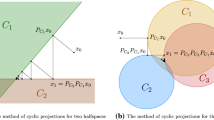Abstract
In recent times the Douglas–Rachford algorithm has been observed empirically to solve a variety of nonconvex feasibility problems including those of a combinatorial nature. For many of these problems current theory is not sufficient to explain this observed success and is mainly concerned with questions of local convergence. In this paper we analyze global behavior of the method for finding a point in the intersection of a half-space and a potentially non-convex set which is assumed to satisfy a well-quasi-ordering property or a property weaker than compactness. In particular, the special case in which the second set is finite is covered by our framework and provides a prototypical setting for combinatorial optimization problems.






Similar content being viewed by others
References
Aragón Artacho, F.J., Borwein, J.M., Tam, M.K.: Douglas–Rachford feasibility methods for matrix completion problems. ANZIAM J. 55(4), 299–326 (2014). doi:10.1017/S1446181114000145
Aragón Artacho, F.J., Borwein, J.M.: Global convergence of a non-convex Douglas–Rachford iteration. J. Glob. Optim. 57(3), 753–769 (2013). doi:10.1007/s10898-012-9958-4
Aragón Artacho, F.J., Borwein, J.M., Tam, M.K.: Recent results on Douglas–Rachford methods for combinatorial optimization problem. J. Optim. Theory. Appl. 163(1), 1–30 (2014). doi:10.1007/s10957-013-0488-0
Borwein, J.M., Tam, M.K.: Reflection methods for inverse problems with application to protein conformation determination. In: Generalized Nash Equilibrium Problems, Bilevel programming and MPEC, New Delhi (2012), (in press)
Borwein, J.M., Tam, M.K.: A cyclic Douglas–Rachford iteration scheme. J. Optim. Theory Appl. 160(1), 1–29 (2014). doi:10.1007/s10957-013-0381-x
Borwein, J.M., Tam, M.K.: The cyclic Douglas–Rachford method for inconsistent feasibility problems. J. Nonlinear Convex Anal. 16(4), 537–584 (2015)
Bauschke, H.H., Dao, M.N., Moursi, W.M.: The Douglas–Rachford algorithm in the affine-convex case. arXiv:1505.06408v1
Bauschke, H.H., Koch, V.R.: Projection methods: Swiss army knives for solving feasibility and best approximation problems with halfspaces. Contemp. Math. 636, 1–40 (2015). doi:10.1090/conm/636
Bauschke, H.H., Noll, D.: On the local convergence of the Douglas–Rachford algorithm. Arch. Math. 102, 589–600 (2014). doi:10.1007/s00013-014-0652-2
Bauschke, H.H., Combettes, P.L., Luke, D.R.: Phase retrieval, error reduction algorithm, and Fienup variants: a view from convex optimization. JOSA A 19(7), 1334–1345 (2002). doi:10.1364/JOSAA.19.001334
Benoist, J.: The Douglas–Rachford algorithm for the case of the sphere and the line. J. Global Optim. (2015). doi:10.1007/s10898-015-0296-1
Borwein, J.M., Sims, B.: The Douglas–Rachford algorithm in the absence of convexity. In: Bauschke, H.H., Burachik, R., Combettes, P.L., Elser, V., Luke, D.R., Wolkowicz, H. (eds.) Fixed-Point Algorithms for Inverse Problems in Science and Engineering, pp. 93–109. Springer, New York (2011). doi:10.1007/978-1-4419-9569-8
Elser, V., Rankenburg, I., Thibault, P.: Searching with iterated maps. Proc. Natl. Acad. Sci. 104(2), 418–423 (2007). doi:10.1073/pnas.0606359104
Hesse, R., Luke, D.R.: Nonconvex notions of regularity and convergence of fundamental algorithms for feasibility problems. SIAM J. Optim. 23(4), 2397–2419 (2013). doi:10.1137/120902653
Hesse, R., Luke, D.R., Neumann, P.: Alternating projections and Douglas–Rachford for sparse affine feasibility. IEEE. Trans. Signal Proc. 62(18), 4868–4881 (2014). doi:10.1109/TSP.2014.2339801
Gravel, S., Elser, V.: Divide and concur: a general approach to constraint satisfaction. Phys. Rev. E 78(3), 036706 (2008). doi:10.1103/PhysRevE.78.036706
Nemhauser, G.L., Wolsey, L.A.: Integer and Combinatorial Optimization. Wiley, New York (1999)
Phan, H.M.: Linear convergence of the Douglas–Rachford method for two closed sets. Optim. (2015). doi:10.1080/02331934.2015.1051532
Acknowledgments
We would like to thank the anonymous referee for their helpful suggestions and comments.
Author information
Authors and Affiliations
Corresponding author
Additional information
F.J. Aragón Artacho was supported by MINECO of Spain and FEDER of EU, as part of the Ramón y Cajal program (RYC-2013-13327) and the Grant MTM2014-59179-C2-1-P. J.M. Borwein was supported, in part, by the Australian Research Council. M.K. Tam was supported by an Australian Post-Graduate Award.
Rights and permissions
About this article
Cite this article
Aragón Artacho, F.J., Borwein, J.M. & Tam, M.K. Global behavior of the Douglas–Rachford method for a nonconvex feasibility problem. J Glob Optim 65, 309–327 (2016). https://doi.org/10.1007/s10898-015-0380-6
Received:
Accepted:
Published:
Issue Date:
DOI: https://doi.org/10.1007/s10898-015-0380-6




